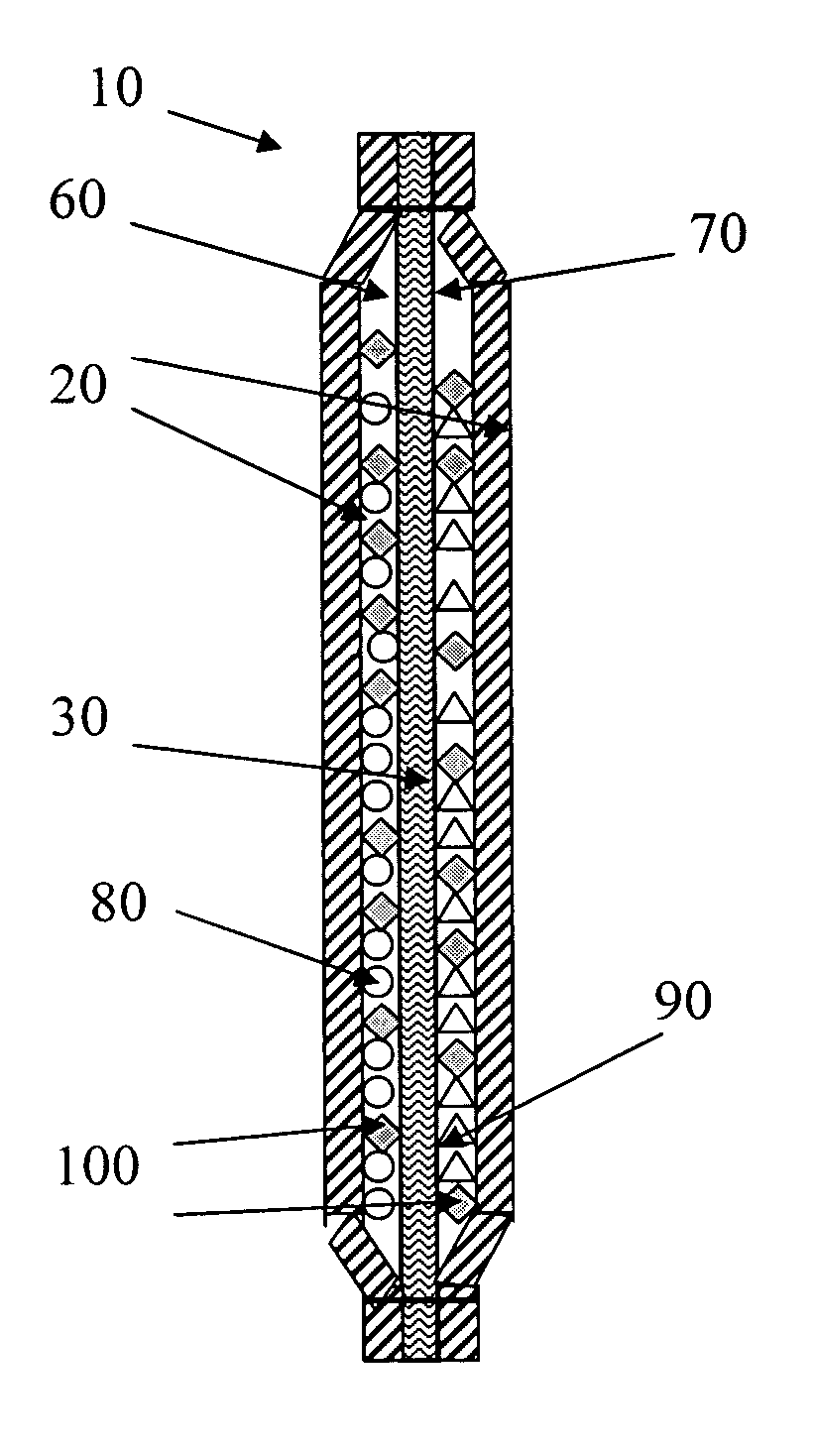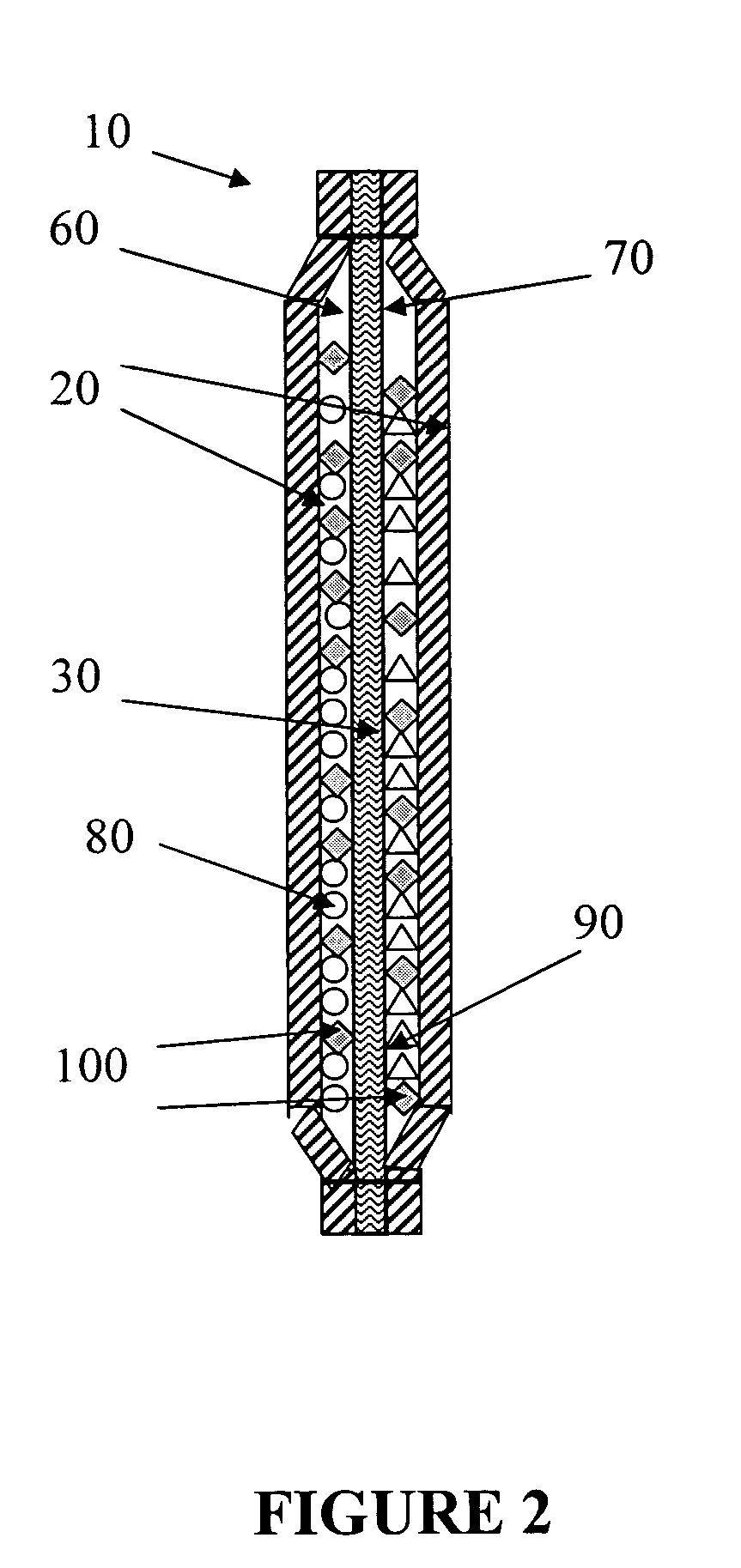Device and methods for the production of chlorine dioxide vapor
a technology of chlorine dioxide and vapor, which is applied in the direction of halogen oxide/oxyacid, disinfection, chemistry apparatus and processes, etc., can solve the problem of accelerating the release of chlorine dioxide vapor, and achieve the effect of reducing the moisture level, and reducing the amount of chlorine dioxide vapor
- Summary
- Abstract
- Description
- Claims
- Application Information
AI Technical Summary
Benefits of technology
Problems solved by technology
Method used
Image
Examples
example 1
[0048] One chamber of pouch A was filled with 1 gram of powdered technical grade sodium chlorite and the other chamber of pouch A was filled with 2 grams of granular sodium acid sulfate. Similarly, pouch B was filled with 1 gram of powdered technical grade sodium chlorite and 2 grams of granular sodium acid sulfate in each chamber. Pouch A was placed into the glass chamber, and the moisture level was raised to 60% relative humidity at room temperature (˜23° C.) after the glass tank was covered. Similarly, Pouch B was placed into the glass chamber under the same conditions as pouch A. The results are shown in Table 1.
TABLE 1Chlorine DioxideChlorine DioxideTimeConcentration (Pouch A)Concentration (Pouch B) 6 hours1.4 ppm 2.5 ppm12 hours 13 ppm>15 ppm
[0049] The results shown in Table 1 demonstrate that the small openings at the two edges of pouch B increase the moisture transfer rate into the device, increase the reactants' dissolution rate and chlorine dioxide generation rate, as we...
example 2
[0050] One pouch B was filled with 1 gram of powdered technical grade sodium chlorite and 2 grams of granular citric acid in each chamber. Compared to pouch B of EXAMPLE 1 under the same condition: 60% relative humidity at room temperature (˜23° C.), the results are shown in Table 2.
TABLE 2Chlorine DioxideChlorine DioxideConcentrationConcentrationTime(sodium acid sulfate)(Citric Acid) 6 hours 2.5 ppm0ppm12 hours>15 ppm0.05ppm36 hours—1.5ppm
[0051] The results shown in Table 2 demonstrate that the strength of acidity affects the chlorine dioxide production. Sodium acid sulfate (pKa=1.99) is a stronger acid than citric acid (pKa 3.14); therefore, chlorine dioxide production is higher when the acidity of acid component is stronger.
example 3
[0052] Three pouches B with similar formulations were prepared as follows: 1 gram of powdered technical grade sodium chlorite in one chamber and 2 grams of granular sodium acid sulfate in other chamber. These pouches were tested at different relative humidity level (40, 60, and 80% R.H.) at room temperature (˜23° C.). The results are shown in Table 3.
TABLE 3Chlorine DioxideChlorine DioxideChlorine DioxideConcentrationConcentrationConcentrationTime(40% R. H)(60% R. H)(80% R. H) 2 hours——>15 ppm 6 hours0.05 ppm 2.5 ppm—12 hours—>15 ppm24 hours0.05 ppm——
[0053] The results shown in Table 3 demonstrate that the higher the of moisture level in the air, the faster the reactant components become hydrated and come into contact with each other through the inner membrane to produce chlorine dioxide vapor.
PUM
| Property | Measurement | Unit |
|---|---|---|
| temperatures | aaaaa | aaaaa |
| pore size | aaaaa | aaaaa |
| reaction rate | aaaaa | aaaaa |
Abstract
Description
Claims
Application Information
 Login to View More
Login to View More - R&D
- Intellectual Property
- Life Sciences
- Materials
- Tech Scout
- Unparalleled Data Quality
- Higher Quality Content
- 60% Fewer Hallucinations
Browse by: Latest US Patents, China's latest patents, Technical Efficacy Thesaurus, Application Domain, Technology Topic, Popular Technical Reports.
© 2025 PatSnap. All rights reserved.Legal|Privacy policy|Modern Slavery Act Transparency Statement|Sitemap|About US| Contact US: help@patsnap.com



